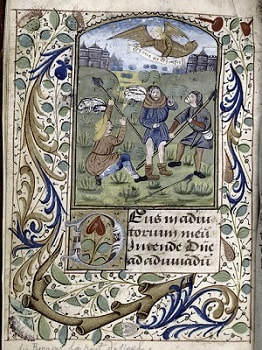Limner
 Do you know anyone who works as a limner? What kind of work is that, anyway? In brief, a limner is a watercolour artist who hand paints illustrations for books and manuscripts.
Do you know anyone who works as a limner? What kind of work is that, anyway? In brief, a limner is a watercolour artist who hand paints illustrations for books and manuscripts.The word limner has its origins in the Proto-Indo-European (PIE) root leuk (light, brightness), PIE leuk-smen (to shine), and Latin lucere (to shine) and lumen (radiant energy, light). From these sources come Latin luminare (illuminate, burnish) and 14th century Old French luminer (light up, illuminate).
By the early 15th century, the verb ‘to limn’ (to illuminate manuscripts) came to English from Middle English luminen and French enluminure (a painting with luminous colours); that is, to limn meant to provide illustrations that both illuminated and ‘enlightened’ the text of a manuscript (“While the English ‘to limn’ originally meant to create text or images in watercolours, it was also a general term for painting…” Evans, 2020).
A person who worked at limning was a lymner or a limner.
Technically speaking, during the medieval and Renaissance periods, limners were illustrators, not painters. Illustrators (or illuminators) of books and manuscripts usually worked in watercolour. Painters, on the other hand, created large paintings usually in oils.
In Renaissance Florence, book illuminators, painters in oils, stationers (book and paper sellers), and physicans[!] belonged to the Guild of Doctors and Apothecaries. Why? Because illuminators and painters bought their pigments from apothecaries. In London, limners and book writers had their own professional association, the Mistery of Stationers, which was separate from the Painters / Stainers Company who worked on cloth (e.g., canvas) and wood. In some places an illuminator or limner had to serve a two-year apprenticeship. Oil painters served a four-year apprenticeship.
The beginning of the end for the work of the limner was the development of the printing press in 1455 and the first printed books by Johannes Gutenberg. Nevertheless, in the 1590s, the term limn was used to mean ‘to portray or depict in watercolour’. However, by this time, the term ‘watercolourist’ rather than limner was appearing more and more in common use.
Other words associated with PIE leuk include elucidate, illustration, leukemia, lucid, Lucifer, luminary, lunacy, lunar, luster, lux, translucent.
References:
Online Etymological Dictionary, https://www.etymonline.com/
Evans, M. (2020). Renaissance watercolours: From Durer to Van Dyck. London: V&A, 14 – 16.
Published on June 02, 2021 20:28
No comments have been added yet.



